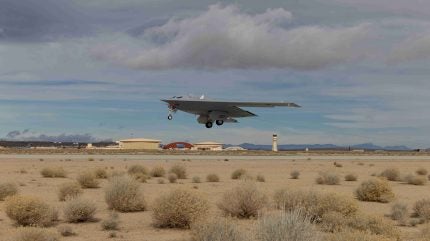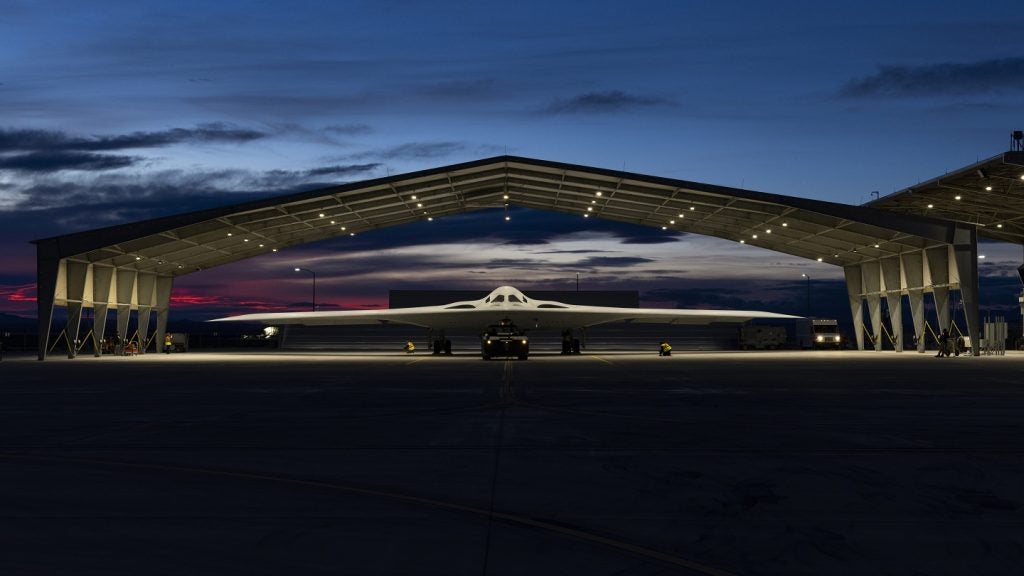
The US Air Force (USAF) has said that it is continuing test flights and production of the B-21 Raider stealth bomber, as the service looks to introduce the next-generation platform on schedule from the mid-2020s onwards.
In a 22 May 2024 release, the USAF stated that since its formal unveiling in December 2022, the B-21 has begun flight testing at Edwards Air Force Base where “it continues to make progress”, with the type scheduled to incrementally replace existing B-1B Lancer and B-2 Spirit which are currently in service.
The long-range, stealth platform is intended to offer the ability to penetrate enemy air defence networks to conduct strikes. The USAF’s minimum production goal is for at least 100 aircraft, which are being manufactured by Northrop Grumman.
During recent testimony at the Senate Armed Services Committee, Andrew Hunter, assistant secretary of the Air Force for Acquisition, Technology and Logistics, highlighted B-21 flight testing was “on track” to meet timelines, according to the USAF.
“We are in the flight test program, the flight test program is proceeding well,” Hunter said in response to a question about the B-21 programme. “It is doing what flight test programs are designed to do, which is helping us learn about the unique characteristics of this platform, but in a very, very effective way.”

The USAF’s Rapid Capabilities Office manages the acquisition programme, focusing on making test aircraft as production representative as possible. Test aircraft are built on the same manufacturing line and use the same manning and tooling that will be used in the eventual production, the service stated.
How well do you really know your competitors?
Access the most comprehensive Company Profiles on the market, powered by GlobalData. Save hours of research. Gain competitive edge.

Thank you!
Your download email will arrive shortly
Not ready to buy yet? Download a free sample
We are confident about the unique quality of our Company Profiles. However, we want you to make the most beneficial decision for your business, so we offer a free sample that you can download by submitting the below form
By GlobalDataRather than a traditional flight prototype approach, B-21 test aircraft are built including mission systems using the same manufacturing processes and tooling for production aircraft, in order to expedite the build process.
The USAF stated that when the B-21 enters the service, Ellsworth AFB, South Dakota, will be the first B-21 main operating base and location of the formal training unit. Whiteman AFB, Missouri, and Dyess AFB, Texas, are the preferred locations for the remaining bases and will receive aircraft as they become available.
B-21: next-generation USAF bomber
On 22 January 2024, the US Department of Defense announced the start of low-scale production on the Northrop Grumman B-21 Raider, with manufacture taking place at USAF Plant 42 in southern California. The programme represents the culmination of the Long-Range Strike Bomber programme, which began in 2011 to create a next-generation bomber for the US Air Force.
Analysis carried out by GlobalData detailed that, adjusted for inflation, the per unit cost was estimated at around $750m, a significant decrease from the $2bn each of the older 20 B-2 bombers cost, the platform it will be replacing.
Economies of scale and improvements in stealth coating for reduced maintenance demands have helped to draw down per unit costs, although the exact figures are held in strict secrecy by the US military.
Due to the platform’s theoretical capabilities of stealth, sensor networking, and optional piloting, the B-21 is considered to be the world’s first sixth-generation aircraft, the next step beyond fifth generation systems like the US-led F-35 or China’s J-31 fighters.
The US is also developing the Next Generation Air Dominance (NGAD) platform, which is planned to be a true sixth-generation fighter to succeed the F-22 Raptor, among other platforms, currently in service.







